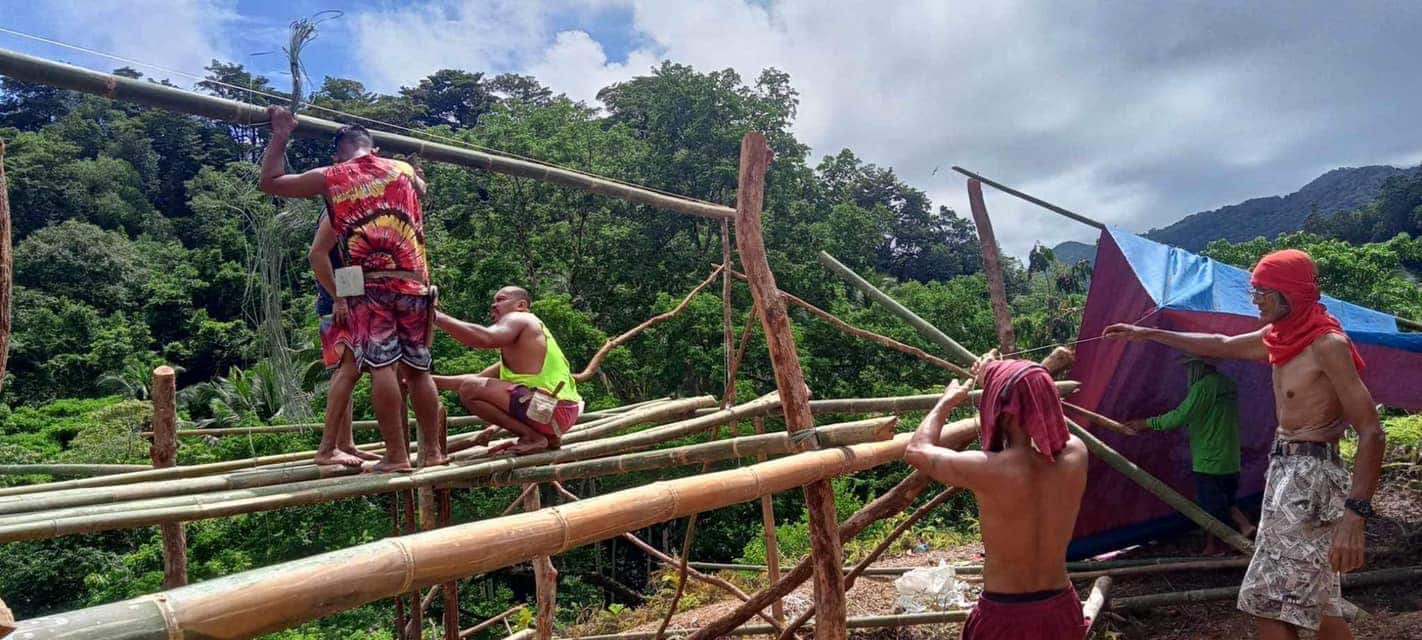
‘DAGYAW’ IN ACTION Men from the Napatag community building their poultry farm, one of the livelihood projects set up for residents on the periphery of the protected Northwest Panay Peninsula Natural Park —PhilinCon
MANILA, Philippines — The Philippines is a global hot spot for threatened, endemic species.
In Panay Island is the Northwest Panay Peninsula Natural Park, one of the largest contiguous low-elevation forest landscapes remaining in the area. In this protected zone, illegal hunting is one of the two major threats to biodiversity, along with habitat loss.
Hunting specifically threatens the critically endangered Visayan warty pig (Sus cebifrons), and many bird species including the endangered Visayan hornbill (Penelopides panini) and the critically endangered Negros bleeding-heart dove (Gallicolumba keayi).
A major project of the Philippine Initiative for Conservation of the environment and the People (PhilinCon) under the Darwin Initiative involves investigating hunting causes and implementing community-led mitigations in the Philippines—a three-year project already in its second year of implementation. This is a UK government conservation grant, primarily led by the Bristol Zoological Society and PhilinCon as the country’s NGO implementing partner.
The project is modeled on a three-pronged conservation approach: first, understanding the drivers of hunting prevalence, as no previous studies have comprehensively carried out surveys in this protected area; second, implementing community-led interventions like alternative livelihoods; and third, holding community education-awareness campaigns and policy lobbying.
PhilinCon has investigated the motivations (e.g., subsistence, trade), scale, and demand for hunting among local communities. In addition to being illegal, with hunters facing legal charges and fines, hunting is an unsustainable and precarious activity due to the biodiversity losses observed in the protected area.
Livelihood projects
Utilizing the information gathered in Year 1, we designed and codeveloped with local communities effective livelihood projects that promote the recovery of threatened species in the protected area, provide more biodiversity-friendly enterprises to augment their daily food sustenance and income, and help alleviate poverty.
Overall, we have made considerable progress toward our stated outcome and have completed all intended tasks within the originally planned Y2 time frame. Livelihood projects have been put up across eight different communities, such as native chicken farming, organic vegetable farming, poultry raising, rice retailing, and native products weaving.
In addition, we have provided support by offering other options to communities that wished to diversify beyond one key project and requested further training and development. We also supported weavers and craft makers in upscaling their indigenous weaves and crafts. We facilitated and supported women groups from three communities to expand their basket-weaving business into new markets, improve product development, and work with other business partners and social entrepreneurs for dedicated spaces for display and marketing.
Now we have established a monthly monitoring process in each community to ensure we are collecting data on income and expenditure. This will allow us to monitor progress toward sustainability and demonstrate whether the livelihood initiatives are generating profit for the participating households.
One of the best practices we have observed in our communities innovating on their projects is the use of “Dagyaw,” or the “Bayanihan” spirit in action, where the members and their families volunteer to help each other set up their livelihood projects. This show of collective effort indicates their high level of commitment to and ownership of the project. This indigenous practice is the core value of the Darwin Project.
The team has also been involved in various conservation outreach activities, such as putting up advocacy booths at local festivals and supporting youth camps organized by partner organizations. Eventually, the project is likely to make a significant, positive contribution to both biodiversity conservation and poverty reduction in northwestern Panay.
By organizing and strengthening the communities on the edges of the protected area, we can slowly engage them strategically to work on enforcement and other conservation efforts, while also promoting their rights and access to resources and biodiversity-friendly enterprises. It is our dream to weave sustainable communities through such efforts.
Legal registration
Lastly, while the community members had initial apprehensions about the success and sustainability of the livelihood projects due to past experiences of failures, the project was able to include a series of capacity-building workshops and trainings on community-based management, project management and systems to ensure that even after the project has ended, the organizations can sustain their livelihood programs.
The community team also successfully registered the eight community associations under the Department of Labor and Employment. This legal registration will give them the confidence to conduct self-organization and governance and increase their leverage to access other LGU and government funds and other community-financing institutions.
Working on conservation requires a multi-pronged approach, taking into account biological, economic, and sociological roadmaps. While we ask community folk not to encroach into protected areas, we also need to offer alternatives on how these communities living on the edges of the protected area can benefit from the conservation efforts through the sustainable use of resources, thus allowing for both the protected area and the community to thrive in harmony.
The author is the executive director of the Philippine Initiative for Conservation of the environment and the People. Parts of this piece were taken from the Darwin Project Year 2 Report of Bristol Zoo and PhilinCon.